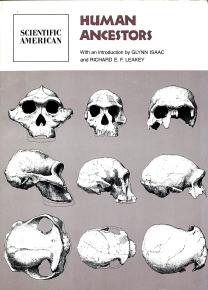Leakey, Richard E.
With an introduction by Glynn Isaac and Richard E. F. LeakeySignatur: A600-B120-D001-A007
Autor: Leakey, Richard E.;
Buchart: Paperback
Verlag: W.H.Freeman and Company, San Francisko (Vereinigte Staaten von Amerika)
Veröffentlichung: 1979
Sprache: Englisch
Seiten: 130
Format: Lex. 8°
Größe (HxBXT): 28,5 x 20,9 cm x 0,7 cm
ISBN 10: 0-7167-1100-1

Bitte loggen Sie sich ein um dieses Dokument ansehen zu können.
Inhaltsverzeichnis:
0. Introduction; 1. Tools and Human Evolution; 2. The Early Relatives of Man; 3. Ramapithecus; 4. The Evolution of the Hand; 5. The Antiquity of Human Walking; 6. The Hominids of East Turkana; 7. The Casts of Fossil Hominid Brains; 8. Homo Erectus; 9. Stone Tools and Human Behavior; 10. The Functions of Paleolithix Flint Tools; 11. The Food-Sharing Behavior of Protohuman Hominids
1. Bibliographies; 2. Index
Kurzbeschreibung:
Umfangreiche anthropologische Darstellung by Scientific American
Textpassagen (Auszüge):
"What kind of beeings are we humans? An age-old question to which, until comparatively recently, different answers were offered by different peoples all over the world. However, all of these answers possessed strong components of myth and mysticism. Most cultures on all continents wove poetic stories of creation into the fabric of their understanding of the nature of human nature. [...]"
0. Introduction; 1. Tools and Human Evolution; 2. The Early Relatives of Man; 3. Ramapithecus; 4. The Evolution of the Hand; 5. The Antiquity of Human Walking; 6. The Hominids of East Turkana; 7. The Casts of Fossil Hominid Brains; 8. Homo Erectus; 9. Stone Tools and Human Behavior; 10. The Functions of Paleolithix Flint Tools; 11. The Food-Sharing Behavior of Protohuman Hominids
1. Bibliographies; 2. Index
Kurzbeschreibung:
Umfangreiche anthropologische Darstellung by Scientific American
Textpassagen (Auszüge):
"What kind of beeings are we humans? An age-old question to which, until comparatively recently, different answers were offered by different peoples all over the world. However, all of these answers possessed strong components of myth and mysticism. Most cultures on all continents wove poetic stories of creation into the fabric of their understanding of the nature of human nature. [...]"